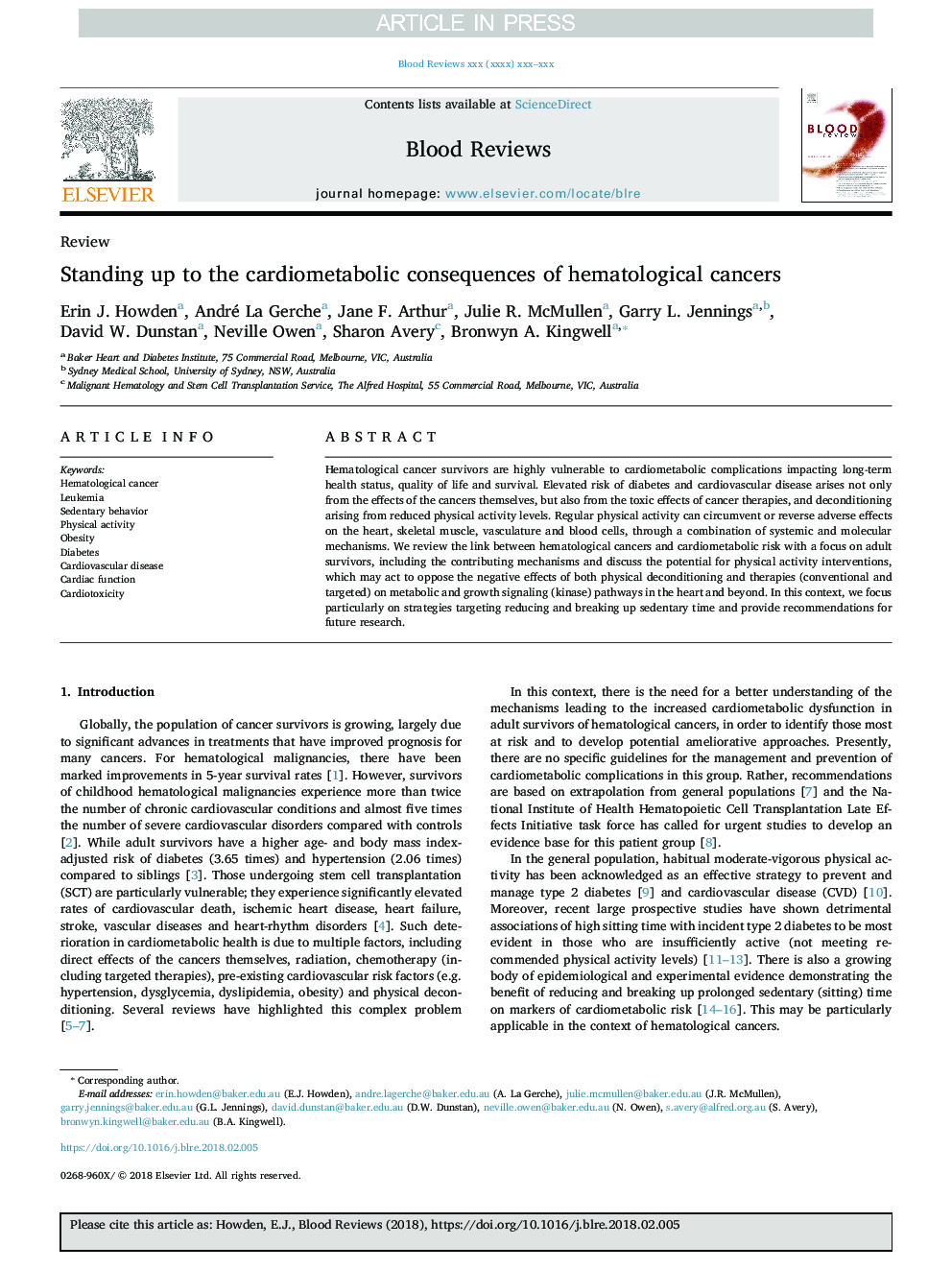| کد مقاله | کد نشریه | سال انتشار | مقاله انگلیسی | نسخه تمام متن |
|---|---|---|---|---|
| 8962119 | 1646541 | 2018 | 12 صفحه PDF | دانلود رایگان |
عنوان انگلیسی مقاله ISI
Standing up to the cardiometabolic consequences of hematological cancers
ترجمه فارسی عنوان
پایبندی به عوارض قلبی عروقی سرطان های هماتولوژیک
دانلود مقاله + سفارش ترجمه
دانلود مقاله ISI انگلیسی
رایگان برای ایرانیان
کلمات کلیدی
سرطان هماتولوژیک، لوسمی، رفتار مفرط، فعالیت بدنی، چاقی، دیابت، بیماری قلب و عروقی، عملکرد قلب، سمیت قلبی،
ترجمه چکیده
بازماندگان سرطان هماتولوژیک بسیار آسیب پذیر هستند به عوارض قلبی - متابولیک که بر وضعیت سلامتی درازمدت، کیفیت زندگی و بقا تأثیر می گذارد. خطر ابتلا به دیابت و بیماری قلبی عروقی نه تنها از طریق اثرات سرطانی خود، بلکه همچنین از اثرات سمی درمان سرطان، و از دست دادن کاهش میزان فعالیت بدنی ناشی می شود. فعالیت بدنی منظم می تواند از طریق ترکیبی از مکانیزم های سیستمیک و مولکولی، اثرات جانبی ناخواسته بر قلب، عضلات اسکلتی، عروق و سلول های خونی را متوقف کند. ارتباط بین سرطانهای هماتولوژیک و خطر ابتلا به سرطان روده را با تمرکز بر بازماندگان بزرگسال، از جمله مکانیزم های کمک کننده و بحث در مورد پتانسیل مداخلات در فعالیت های فیزیکی بررسی می کنیم، که ممکن است با مخالفت با اثرات منفی هر دو درمان فیزیکی و درمان (متعارف و هدفمند) بر روی متابولیسم و رشد سیگنالینگ (کیناز) در قلب و فراتر از آن. در این زمینه، ما به ویژه در استراتژی هایی که هدفشان کاهش و شکستن زمان های ماندگار است و توصیه هایی برای تحقیقات آینده ارائه می کنیم، تمرکز می کنیم.
موضوعات مرتبط
علوم زیستی و بیوفناوری
بیوشیمی، ژنتیک و زیست شناسی مولکولی
تحقیقات سرطان
چکیده انگلیسی
Hematological cancer survivors are highly vulnerable to cardiometabolic complications impacting long-term health status, quality of life and survival. Elevated risk of diabetes and cardiovascular disease arises not only from the effects of the cancers themselves, but also from the toxic effects of cancer therapies, and deconditioning arising from reduced physical activity levels. Regular physical activity can circumvent or reverse adverse effects on the heart, skeletal muscle, vasculature and blood cells, through a combination of systemic and molecular mechanisms. We review the link between hematological cancers and cardiometabolic risk with a focus on adult survivors, including the contributing mechanisms and discuss the potential for physical activity interventions, which may act to oppose the negative effects of both physical deconditioning and therapies (conventional and targeted) on metabolic and growth signaling (kinase) pathways in the heart and beyond. In this context, we focus particularly on strategies targeting reducing and breaking up sedentary time and provide recommendations for future research.
ناشر
Database: Elsevier - ScienceDirect (ساینس دایرکت)
Journal: Blood Reviews - Volume 32, Issue 5, September 2018, Pages 349-360
Journal: Blood Reviews - Volume 32, Issue 5, September 2018, Pages 349-360
نویسندگان
Erin J. Howden, André La Gerche, Jane F. Arthur, Julie R. McMullen, Garry L. Jennings, David W. Dunstan, Neville Owen, Sharon Avery, Bronwyn A. Kingwell,
